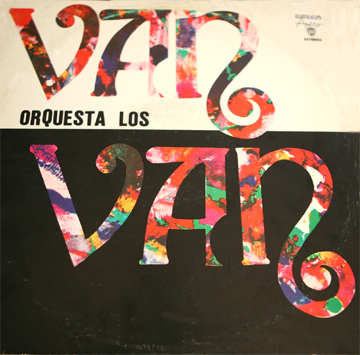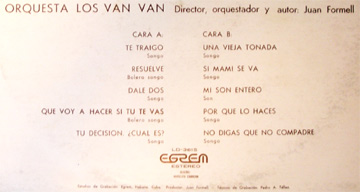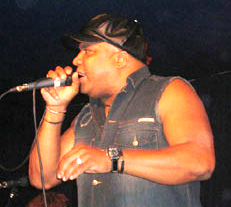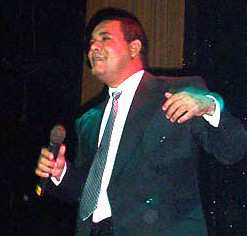Indice - Table of contents
Lo Nuevo[hide]
Reportes: From The St... : Cubadisco 2...
Fotos: Tom Ehrlich
Staff: Kristina Lim
Musicos: Juan Formell
Musicos: Yordamis Megret Planes
Musicos: Yasser Morejón Pino
Musicos: José Luis "Changuito" Quintana...
Musicos: Dennis Nicles Cobas
Fotos: Eli Silva
Grupos: Ritmo Oriental : 1988 - Vol. IX - 30 a...
Musicos: Rafael Paseiro Monzón
Musicos: Jiovanni Cofiño Sánchez
Fotos: Tom Ehrlich : 2024 Monterey Jazz, P...
Resenas: Vacilón Santiaguero (Circle 9 ...
Fotos Del Día [hide]
The Roots of Timba - Part II - Los Van Van, Volume IV


1976 - Los Van Van, Vol. 4 (LD-3615)
The intense creative energy generated by a "perfect storm" affects everyone in its wake -- each in a different way -- nurturing and magnifying whatever talent and aesthetic concepts are laying dormant. For example, in 1997, Bamboleo, Klímax and Manolito produced some of their best work. All three were inspired by the electrifying mood on streets of Havana, but it's hard to believe that the following three audio examples represent the same genre in the year. Each is brilliant, but they could scarcely be more different:
Bamboleo - Película vieja (source)
Klímax - Aún así (source)
Manolito - El águila (source)
So it was in 1976. Los Van Van IV seems to exist in a different solar system, not only from the Ritmo Oriental tracks we've just studied, but from Van Van's previous work as well.
1976 Los Van Van - Te traigo (EPA-6886B)
xx0x 0xxx 0xx0 xxx0 2-3 rumba clave
0xx0 xxxx xxx0 xxxx kick
0x00 x000 x0x0 x00x
0x00 x000 xxx0 xx0x tumbao 1 -- MIDI
bass: Juan Formell - drums: Changuito
source: Los Van Van, Vol. IV
Throughout Volume IV, Formell juxtaposes intense minor key songo grooves with richly melodic pop songwriting in major keys, giving the "album" as distinct a personality as its two predecessors. The first track sets the tone. After tumbao 1, the contrast of the sentimental cuerpo is almost shocking. Beneath the surface, however, the songo rhythms are still raging. Changuito varies his kick drum a lot, but keeps returning to a pattern which lasts two claves before repeating.
0xx0 xxxx xxx0 xxxx
00x0 xxxx xxx0 xxxx kick MIDI
The idea of a repeating percussion pattern that spans multiple claves is an extremely forward-looking concept which occurs in the more advanced timba conga marchas, but still hasn't become common practice even in 2007. The extent of Changuito's visionary imagination during this period never ceases to amaze.
The relatively slow tempo of 90 bpm is right at the cusp where Formell begins to play bass tumbao figures with 3 or more consecutive notes (x000).
Formell takes his time developing the long cuerpo before transitioning back to hard-driving minor key songo via an extensive quote from the old Cuban standard Noche cubana by César Portillo de la Luz.
This time the minor section switches to the bombo-ponche approach (with a doubled ponche).
xx0x 0xxx 0xx0 xxx0 2-3 rumba clave
xxxx xxxx xxxx xx00 bass pickups
xxx0 xx00 xxx0 xx00 tumbao 2 -- MIDI
Oddly, the tumbao from the introduction never returns. Perhaps it was reprised in extended live performances.
Te traigo, interestingly, was released as the B-side of Una vieja tonada. Without having heard the 45, we can guess that it was excerpted from the long opening album track as EGREM did with the single of Guararey from Volume III. The early singles from Volume II were different recordings from the same songs on the LP, but from Volume III on, we have no evidence of this happening and we think the 45s were drawn from the same recordings sessions. If you can confirm or deny, please send email. We hope that readers will think of this "online book" as a sort of Timba Wikipedia where you can learn from the research of others and return the favor by giving the world the benefit of your own studies.
1976 Los Van Van - Resuelve (EPA-6912B)
xx0x 0xxx 0xx0 xxx0 2-3 rumba clave
KKxx SxxK xKxx Sxxx kick and snare
0000 0000 x000 x000 tumbao 1 -- MIDI
bass: Juan Formell - drums: Changuito
source: Los Van Van, Vol. IV
notes: Resuelve is the same basic bolero songo groove as La Habana joven and Llegué llegué from the previous two albums.
The tempo (~56 bpm) is about half as fast as normal songo, but Changuito's embellishments hint at double time. Other than the bridge, his snare hits faithfully on both backbeats, as it does on Llegué llegué, but in contrast to La Habana joven where he usually hits the backbeat of the 2-side, but plays all sorts of variations on the 3-side.
Formell's bassline strongly supports the slower tempo, but note that as he usually does, he lays down about twice as many notes per measure. In other words, Formell tends to play about the same number of notes per minute regardless of the number of beats per minutes
Pupy Pedroso's keyboard part is very unusual -- he plays block chords using a variation of the contracampana rhythm normally played on the timbalero's bell (0x0x 0000 x000 0000).
Resuelve was also released as the B-side of No digas que no, compadre. Again, by this point, we think all the singles contained the same recordings as the LPs.
1976 Los Van Van - Dale dos (EPA-6912B)
bass: Juan Formell - drums: Changuito
source: Los Van Van, Vol. IV
xx0x 0xxx 0xx0 xxx0 2-3 rumba clave
00xx x0xx x0xx x0xx tumbao 1 -- MIDI
notes: One of the beauties of x & 0 notation is that it makes it gives each pulse such a recognizable identity relative to both the beat and the clave. For example, take this figure: x0xx. In standard yuma 8th note notation, it would just be one more "and", but the second pulse of each group of 4 has a special extra measure of syncopation that became hugely important in timba. In tumbao 1, LVV gives us a concentrated dose.
xx0x 0xxx 0xx0 xxx0 2-3 rumba clave
xxx0 0x0x xxx0 0x0x
xxx0 0x0x xxx0 0x0x tumbao 2 -- MIDI
notes: Tumbao 2 is just doubled bombo and ponche, but the bluesy choice of notes moves it into the "cantado" category -- it has a melodic as well as a rhythmic identity, and the song can be identified just by hearing the bass part.
xx0x 0xxx 0xx0 xxx0 2-3 rumba clave
xxx0 xxxx xxxx xxxx kick
0xx0 x0x0 xxx0 0x0x tumbao 3 -- MIDI
notes: The last tumbao is the closest to typical songo. Only the slower tempo (96 bpm) separates this section from the great majority of bass tumbaos we've been studying.

Roberto "Robertón" Hernández - singer of the 2007 version of Dale dos
Dale dos has always been one of the most popular songs of this era and as of 2007, LVV has been playing a new live version, albeit with a much more generic doubled-bombo-ponche bass tumbao.
1976 Los Van Van - Qué voy a hacer si tú te vas (EPA-6696A)
bass: Juan Formell - drums: Changuito
source: Los Van Van, Vol. IV
Si tú te vas, one of the of the most beautiful songs of the 70s, was also the inspiration for two very different but equally brilliant new arrangements in the 1994 and 2001. Formell called the original version bolero songo, embellishing the standard bolero bass rhythm with beautiful modern chords, Changuito's modified backbeat, a bit of Jamersonesque double time funkiness in the bass (and congas), and LVV's take on con efecto.
Here's the basic chord progression as a generic bolero:
0xxx 0x0x 0xxx 0x0x standard bolero bass tumbao
And here's the LVV version:
0xxxxxx0 000x0x0x 0xxxxxx0 x000x000
xxxxxxxx 00x0x0x0 0xxxxxxx 000x0000 audio -- MIDI
The double time inferences require us to write it such that there are 8 x's per beat, but the tempo never feels doubled. Also, listen for the con efecto tempo change on the last beat of both the audio and MIDI examples.

Ángel Bonne - singer of the 1994 and 1999 versions of Si tú te vas
There were two wonderful remakes of Si tú te vas in the 90s. LVV did an up-tempo version on Lo último en vivo (one of their greatest albums, by the way), and Ángel Bonne (the singer of the second LVV version) recorded a gorgeous ballad version on his solo album Ésta es mi música.





















